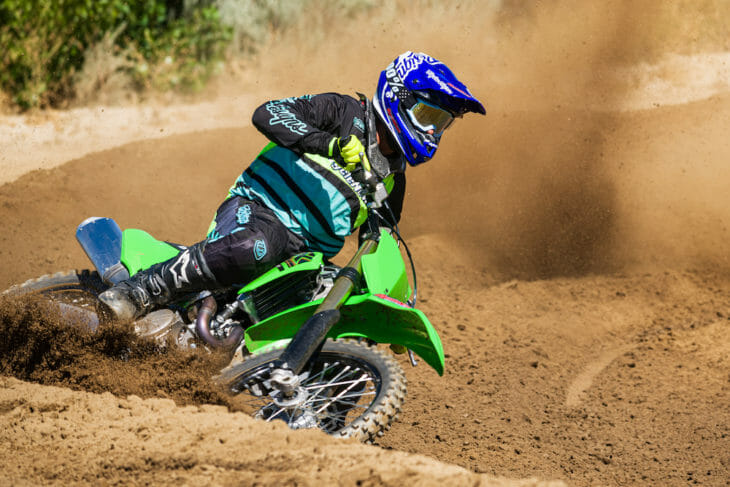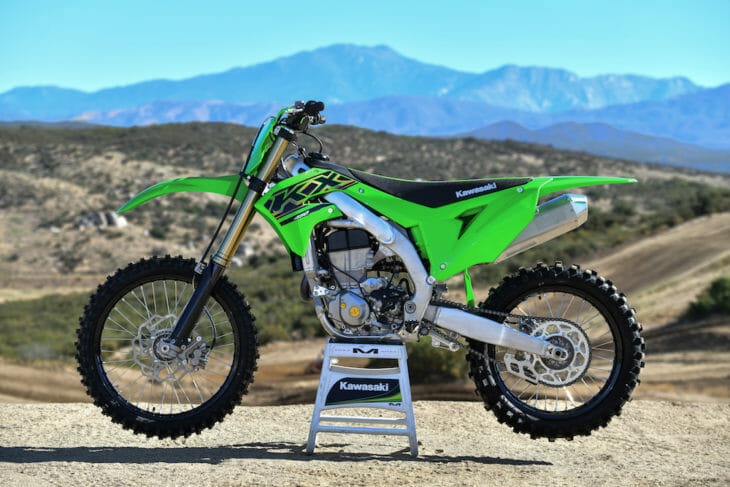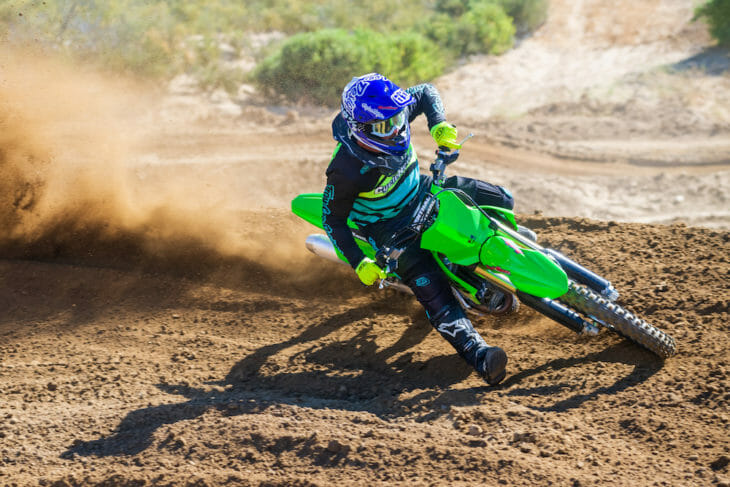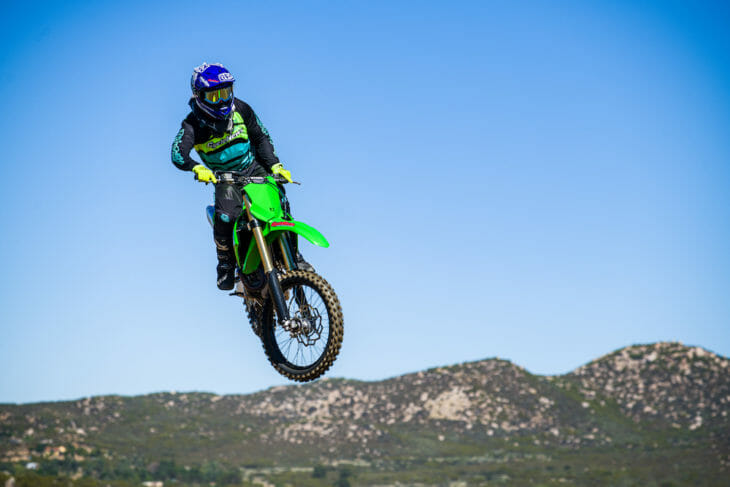| July 17, 2020
It’s been over two decades since the motocross world first saw the potential of a four-stroke as a legitimate motocross racing machine, and now, standing in front of the latest 2021 450cc from Kawasaki, it’s amazing to see just how far the industry has come. I was reminded of this again when Kawasaki gave Cycle News its first chance to ride the 2021 KX450.
 Kawasaki didn’t make a whole lot of changes to the 2021 KX450 but what they did do certainly didn’t hurt. We like what we felt after our first day on the bike. Photos: Kit Palmer
Kawasaki didn’t make a whole lot of changes to the 2021 KX450 but what they did do certainly didn’t hurt. We like what we felt after our first day on the bike. Photos: Kit Palmer
Just as most manufacturers have had ebbs and flows of category supremacy throughout the years, the KX450 has had its share of success as shootout winner, runner-ups, as well as being a little further down in the pecking order. With only subtle–well, mostly subtle–changes made to the 2021 Kawasaki, will they be enough to put the KX450 on top once again?
The new KX450 isn’t a whole lot different than the previous model, but don’t read that as Kawasaki just sitting on their hands and chilling, because what changes Kawasaki did make are good ones.
On the track, the KX feels much the same as before–the chassis is nimble yet neutral, by that I mean, while it turns excellent, it also is very stable and balanced. The bike doesn’t pitch excessively when under braking or acceleration, it remains stable in chop and doesn’t react unexpectedly when encountering an unknown bump on the track.
 The KX450 got a major revision in 2019. One of those revisions was getting a hydraulic clutch. It’s still hydraulic but now operates via cone spring instead of coil springs. The difference is huge.
The KX450 got a major revision in 2019. One of those revisions was getting a hydraulic clutch. It’s still hydraulic but now operates via cone spring instead of coil springs. The difference is huge.
The suspension is, in my opinion, some of the best that ever come standard on a production motorcycle. The Showa suspension is termed “A-Kit Inspired,” meaning it’s very similar to the stuff that has been used by top-level race teams for years. No doubt it’s a bit behind the top-secret factory suspension that currently graces Adam Cianciarulo’s KX450, but it shares many of the design features as the A-Kit units that the general public can purchase, which retail for around $10,000 for forks and shock (note: there is a big difference between factory suspension and “kit” suspension, the main difference being that you can’t buy factory suspension). The 49mm fork is plush, yet still holds up very well when pushed through the stroke. In fact, I made only minor changes from the set baseline that we started with settling on two clicks slower rebound and two clicks stiffer compression, mostly due to specific track nuances. The shock is equally as versatile and impressive, with minor adjustments we got the backtracking over acceleration chop and firmly planted exiting corners.
Like the fork I only made minor adjustments and found comfort. I like a bike to steer with the rear, so for that reason, I ran 110mm sag versus 104mm standard and two clicks slower rebound. However, if you like the bike to pivot off the front wheel more, run the recommended 104mm of sag, you’ll be rewarded with a very sharp handling bike.
The engine on Kawasaki’s 450 machines have been a strong suit for the brand for years, I don’t think (to the best of my memory) that a KX450 has ever had a weak engine. In fact, I remember around 2010 Kawasaki actually detuned their engine due to feedback that it was too aggressive. However, in the past few years, they seem to have found the sweet spot. The engine is potent, very potent, but still extremely manageable. Pair that with the included DFI couplers which allow you to tune the power delivery, and you have an engine that will give you as much power as you need in the fashion that you desire.
 The KX450 also has new handlebars and special friction-reducing coating for the piston.
The KX450 also has new handlebars and special friction-reducing coating for the piston.
Now for the new stuff. The 2021 Kawasaki KX450 has a short list of changes: a new coned disk-spring hydraulic clutch, a new Belleville washer spring for the clutch, larger-diameter clutch plates, and revised friction material, new dry film lubricant coating on the piston skirt, and a new 1-1/8” Renthal Fatbar handlebar.
As you can see, the big news here is the clutch. Kawasaki thought outside the box here and did away with the multi-spring pressure plates that have seemingly been used on MX bikes since day one. Instead, the KX450’s clutch now uses a cone, or cupped, disc spring instead of coil springs. Kawasaki isn’t the first to go in this direction. KTM uses a similar design called Damped Diaphragm Steel (DDS) in some of its dirt bikes, but this is a first for a 450cc Japanese motocrosser. Did it pay off? Absolutely! Personally, I’ve never been a fan of hydraulic clutches due to their engagement feel and modulation abilities. Hydraulic clutches typically have an on/off feel, so fanning or feathering the clutch when exiting a corner can be difficult to get the pull just right, especially when in the heat of a battle or at max heart rate.
To combat this, Kawasaki engineers redesigned every aspect of the clutch, even tackling the way the plates separate from each other. While this may seem unwarranted, if you have ever changed your own clutch, think of how hard plates stick to each other when covered in oil. Often times the suction is so strong you have to slide the plates to get them to separate. Now think of trying to separate every fiber from every steel without the sliding and all at once. It takes a lot of effort. Kawasaki redesigned the fibers to allow for easier separation, therefore resulting in a lighter feel and smoother engagement.
The Belleville spring washer has a smoother and more progressive compression than traditional springs, again, allow for easier pull and smoother clutch action. All in all, this equates to a hydraulic clutch that has the engagement feel of a traditional cable clutch yet still has the soft pull of a hydraulic system. It really is the best of both worlds. And, it should be more durable than the previous design.
 The KX450 still feels light and agile.
The KX450 still feels light and agile.
Besides the clutch, for performance, there was a minor change with the addition of a dry film lubricant to the piston skirts. If I had ridden the 2020 and 2021 KX450s back to back, perhaps this addition could be felt, but drawing from memory, it seems the same. That’s not to say it’s pointless. Adding special coatings to these parts has been very common for years in all forms of racing, from MX to F1, adding friction-reducing coatings to make the engine run more efficient is a no brainer.
Finally, the 1-1/8-inc Renthal Fatbar Handlebar. While my preference would have been a Renthal Twinwall handlebar for better front end feel and feedback, it is a very stiff bar and many people do not like this bar for that reason. The Renthal Fatbar has a much more forgiving and comfortable feel due to lack of crossbar which allows for an amount of flex, an additional benefit to this design is that it helps cut down on vibration both from the engine and terrain. Regardless of bar design preference, having a 1-1/8-inch handlebar standard means you have 1-1/8-inch clamps standard. Therefore, allowing you to choose your style of handlebar without having to purchase aftermarket bar clamps.
So, after getting a total rebuild—new chassis, motor, and hydraulic clutch—in 2019, the KX450 gets its first update since then (the bike was unchanged in 2020), and, so far, we’ve like what they’ve done. Getting a re-vamped clutch might not seem like a lot, but I can safely say that it is one change that made an already very good motorcycle even better. CN
By Chris Siebenhaar
Click here for the latest Cycle News Motocross bike reviews and news.